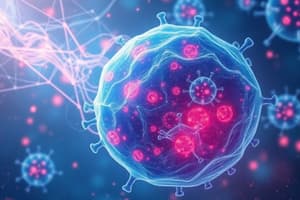Podcast
Questions and Answers
What type of hypersensitivity reaction is the Th2 response to allergens?
What type of hypersensitivity reaction is the Th2 response to allergens?
- Type III
- Type I (correct)
- Type IV
- Type II
What is the main step involving mast cell degranulation in an allergic reaction?
What is the main step involving mast cell degranulation in an allergic reaction?
- Stimulation of allergen-specific IgE Abs production
- Crosslinking of IgE Abs on mast cells (correct)
- Allergens binding to Fc receptors on mast cells
- Release of mediators like histamine and leukotrienes
Which molecule is responsible for bronchoconstriction and vasodilation in allergic reactions?
Which molecule is responsible for bronchoconstriction and vasodilation in allergic reactions?
- Cytokines
- Leukotrienes
- Prostaglandins
- Histamine (correct)
What effect does leukotrienes have in comparison to histamine in allergic reactions?
What effect does leukotrienes have in comparison to histamine in allergic reactions?
Which cytokine stimulates IgE production in allergic reactions?
Which cytokine stimulates IgE production in allergic reactions?
What is the main role of IL-5 in allergic reactions?
What is the main role of IL-5 in allergic reactions?
Which medication is considered the gold standard for chronic control and prevention of asthma?
Which medication is considered the gold standard for chronic control and prevention of asthma?
What type of receptors do antihistamines primarily block?
What type of receptors do antihistamines primarily block?
Which physiological antagonist is used as a bronchodilator in asthma therapy?
Which physiological antagonist is used as a bronchodilator in asthma therapy?
What mediates the late asthmatic response, occurring 2-8 hours after exposure to an antigen?
What mediates the late asthmatic response, occurring 2-8 hours after exposure to an antigen?
Which long-term effect of asthma can lead to irreversible airway remodeling?
Which long-term effect of asthma can lead to irreversible airway remodeling?
What are the goals of asthma therapy according to the text?
What are the goals of asthma therapy according to the text?
Flashcards are hidden until you start studying
Study Notes
Allergic Response
- Allergic individuals mount an exaggerated antibody-mediated response initiated by T-helper type 2 (Th2) lymphocytes, a Type I IgE mediated hypersensitivity reaction.
- The reaction involves initial exposure to allergens, which penetrate mucosal surfaces and stimulate the production of allergen-specific IgE antibodies.
Steps Involved in Reaction
- IgE antibodies bind to Fc receptors on mast cells, leading to sensitization of mast cells.
- On second exposure, allergens induce cross-linking of IgE antibodies on mast cells, causing mast cell degranulation and release of mediators.
Mediators Released
- Histamine: causes bronchoconstriction, vasodilation, increased capillary permeability, and itching and pain.
- Leukotrienes: cause bronchoconstriction, bronchospasm, increased mucus secretion, vasodilation, and increased vascular permeability.
- Cytokines and chemokines: stimulate formation of inflammatory mediators, infiltration of inflammatory cells, and proliferation and activation of immune cells.
Strategies to Counteract Mediators
- Prevent release of mediators: inhaled corticosteroids (ICS) and mast cell stabilizers (cromolyn).
- Block receptors for mediators or transmitters: histamine receptor antagonists (antihistamines), leukotriene receptor antagonists, and muscarinic receptor antagonists (anticholinergics).
- Use physiological "antagonist": alpha1-adrenergic receptor stimulants (decongestants) and beta2-adrenergic receptor agonists (bronchodilators).
- Block IgE and cytokines: monoclonal antibodies against IgE and cytokines.
Characteristics of Asthma
- Airway hyperresponsiveness: immune response even in absence of initial allergen due to airway remodeling.
- Airway inflammation: chronic and requires control treatment.
- Bronchoconstriction: acute and requires rescue treatment.
Pathogenesis of Asthma
- Immunologic model: re-exposure to antigen induces a two-phased response, including early and late asthmatic responses.
- Early asthmatic response: Ab-mediated release of mediators, reversible with bronchodilator.
- Late asthmatic response: cytokine-mediated infiltration of inflammatory cells and release of mediators, leading to irreversible airway remodeling.
Goals of Asthma Therapy
- Prevent chronic and troublesome symptoms.
- Require infrequent use (≤ 2 days/week) of inhaled SABA.
- Maintain (near) normal pulmonary function.
- Maintain normal activity (exercise, work, etc.).
Studying That Suits You
Use AI to generate personalized quizzes and flashcards to suit your learning preferences.




